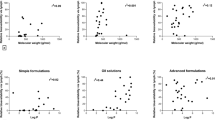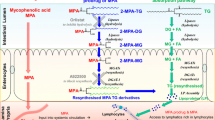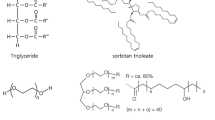Abstract
Purpose. To compare the influence of triglyceride vehicle intramolecular structure on the intestinal lymphatic transport and systemic absorption of halofantrine in conscious rats.
Methods. Conscious, lymph cannulated and nonlymph cannulated rats were dosed orally with three structurally different triglycerides; sunflower oil, and two structured triglycerides containing different proportion and position of medium-(M) and long-chain (L) fatty acids on the glycerol backbone. The two structured triglycerides were abbreviated MLM and LML to reflect the structural position on the glycerol. The concentration of halofantrine in blood and lymph samples was analyzed by HPLC.
Results. Both the lymphatic transport and the total absorption of halofantrine were enhanced by the use the MLM triglyceride. The estimated total absorption of halofantrine in the lymph cannulated animals was higher than in the nonlymph cannulated animals, and this was most pronounced for the animals dosed with the structured triglycerides.
Conclusions. Using MLM as vehicle increases the portal absorption of halofantrine and results in similar lymphatic transport levels when compared to sunflower oil. Total absorption when assessed as absorption in the blood plus lymphatic transport for halofantrine after administration in the MLM triglyceride was higher than after administration in sunflower oil.
Similar content being viewed by others
REFERENCES
W. N. Charman. Lipid vehicle and formulation effects on intestinal lymphatic drug transport. In: W. N. Charman and V. J. Stella (eds), Lymphatic transport of drugs, CRC Press, Boca Raton, 1992, pp. 113–178.
C. J. H. Porter and W. N. Charman. Uptake of drugs into the intestinal lymphatics after oral administration. Adv. Drug. Del. Rev. 15:71–89 (1997).
C. J. H. Porter. Drug delivery to the lymphatic system. Crit. Rev. Therap. Drug Carrier Syst. 14:333–393 (1997).
C. J. H. Porter and W. N. Charman. Intestinal lymphatic drug transport: an update. Adv. Drug Del. Rev. 50:61–80 (2001).
D. M. E. Pocock and A. Vost. DDT absorption and chylomicron transport in rat. Lipids 9:374–381 (1974).
J. Y. Kiyasu, B. Bloom, and I. L. Chikoff. The transport of absorbed fatty acids. J. Biol. Chem. 199:415–419 (1952).
K. J. Palin and C. G. Wilson. The effect of different oils on the absorption of probucol in the rat. J. Pharm. Pharmcol. 36:641–643 (1984).
T. Noguchi, W. N. Charman, and V. J. Stella. The effect of drug lipophilicity and lipid vehicles on the lymphatic absorption of various testosterone esters. Int. J. Pharm. 24:173–184 (1985).
S. Caliph, W. N. Charman, and C. J. H. Porter. Effect of short-, medium-and long-chain fatty acid-based vehicles on the absolute oral bioavailability and intestinal lymphatic transport of halofantrine and assessment of mass balance in lymph-cannulated and non-cannulated rats. J. Pharm. Sci. 89:1073–1084 (2000).
W. N. Charman and V. J. Stella. Estimating the maximal potential for intestinal lymphatic transport of lipophilic drug molecules. Int. J. Pharm. 34:175–178 (1986).
C. J. H. Porter, S. A. Charman, and W. N. Charman. Lymphatic transport of halofantrine in the triple-cannulated anesthetized rat model: Effect of lipid vehicle dispersion. J. Pharm. Sci. 85:351–356 (1996).
C. J. H. Porter, S. A. Charman, A. J. Humberstone, and W. N. Charman. Lymphatic transport of halofantrine in the conscious rat when administered as either the free base or the hydrochlorid salt: effect of lipid class and lipid vehicle dispersion. J. Pharm. Sci. 85:357–361 (1996).
D. J. Hauss, S. E. Fogal, and G. W. Radebaugh. Targeted lymphatictransport and modified systemic distribution of CI-976, a lipophilic lipid-regulator drug, via a formulation approach. Int. J. Pharm. 108:85–93 (1994).
A. J. Humberstone, C. J. H. Porter, G. A. Edwards, and W. N. Charman. Association of halofantrine with postprandially derived plasma lipoproteins decreases its clearance relative to administration in the fasted state. J. Pharm. Sci. 87:936–942 (1998).
K. M. Wasan and S. M. Cassidy. Role of plasma lipoproteins in modifying the biologic activity of hydrophobic drugs. J. Pharm. Sci. 87:411–424 (1988).
B. Nordskog, C. T. Phan, D. F. Nutting, and P. Tso. An examination of the factors affecting intestinal lymphatic transport of dietary lipids. Adv. Drug Del. Rev. 50:21–44 (2001).
. H. Mu, X. Xu, and C.-E. Høy. Production of specific structured triacylglycerols by lipase-catalyzed interesterification in a laboratory scale continuous reactor. J. Am. Oil. Chem. Soc. 75:1187–1193 (1998).
S. W. Christopherson and R. L. Glass. Preparation of milk fat methyl esters by alcohydrolysis in an essentially nonalcholic solution. J. Dairy. Sci. 52:1289–1290 (1969).
C. C. Becker, A. Rosenquist, and G. Hølmer. Regiospecific analysis of triacylglycerols using allyl magnesium bromide. Lipids 28:147–149 (1993).
T. Porsgaard, E. M. Straarup, and C.-E. Høy. Lymphatic fatty acid absorption profile during 24 hours after administration of triglycerides to rats. Lipids 34:103–107 (1999).
A. J. Humberstone, G. J. Currie, C. J. H. Porter, M. J. Scanlon, and W. N. Charman. A simplified liquid chromatography assay for the quantitation of halofantrine and desbutylhalofantrine in plasma and identification of a degradation product of desbutylhalofantrine formed under alkaline conditions. J. Pharm. Biomed. Anal. 13:265–272 (1995).
A. A. A. El-Sayed and A. J. Repta. Solubilization and stabilization of an investigational antineoplastic drug (NSC-278214) in an intravenous formulation using an emulsion vehicle. Int. J. Pharm. 13:303–312 (1983).
T. Noguchi, W. N. Charman, and V. J. Stella. Lymphatic appearance of DDT in thoracic or mesenteric lymph duct cannulated rats. Int. J. Pharm. 24:185–192 (1985).
T. J. Raub, S. L. Douglas, G. W. Melchior, W. N. Charman, and W. Morozowich. Methodologies for assessing intestinal lymphatic transport. In: W. N. Charman and V. J. Stella (eds), Lymphatic transport of drugs, CRC Press, Boca Raton, 1992, pp. 113–178.
B. D. Anderson and M. T. Marra. Chemical and related factors controlling lipid solubility. Bull. Tech. Gattefosse 92:11–18 (1999).
W. N. Charman and V. J. Stella. Effect of lipid class and lipid vehicle volumen on the intestinal lymphatic transport of DDT. Int. J. Pharm. 33:165–172 (1986).
R. Holm, A. Müllertz, G. P. Pedersen, and H. G. Kristensen. Comparison of the lymphatic transport of halofantrine administered in disperse systems containing three different unsaturated fatty acids. Pharm. Res. 18:1299–1304 (2001).
T. G. Redgrave, D. R. Kodali, and D. M. Small. The effect of triacyl-sn-glycerol structure on the metabolism of chylomicrons and triacylglycerol-rich emulsions in the rat. J. Biol. Chem. 263: 5118–5123 (1988).
B. C. Mortimer, D. J. Holthouse, I. J. Martins, R. V. Stick, and T. G. Redgrave. Effects of triacylglycerol-saturated acyl chains on the clearance of chylomicron-like emulsions from the plasma of the rat. Biochim. Biophys. Acta 1211:171–180 (1994).
Author information
Authors and Affiliations
Corresponding author
Rights and permissions
About this article
Cite this article
Holm, R., Porter, C.J.H., Müllertz, A. et al. Structured Triglyceride Vehicles for Oral Delivery of Halofantrine: Examination of Intestinal Lymphatic Transport and Bioavailability in Conscious Rats. Pharm Res 19, 1354–1361 (2002). https://doi.org/10.1023/A:1020311127328
Issue Date:
DOI: https://doi.org/10.1023/A:1020311127328




